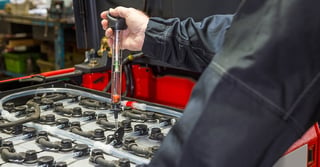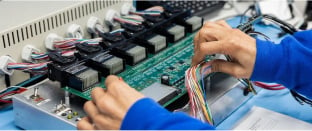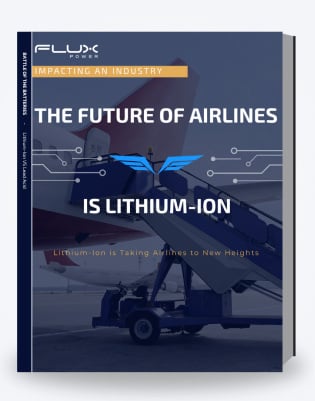When a company is faced with a drop in workload, it is often tasked with temporarily cutting certain areas of its operations.
For operations that use forklifts, lead acid battery maintenance may be among the first to go when trimming workloads, especially if forklifts aren’t in use.
This presents a serious problem that can have significant financial repercussions. Ongoing maintenance of forklift batteries is critical to ensuring the battery lasts its intended lifespan. This is especially true with lead acid batteries, which require ongoing maintenance.
Even worse, if battery maintenance is neglected for a significant period of time, serious damage may occur to the point where a battery needs to be replaced.
If you find yourself dealing with this scenario, or are evaluating your battery options moving forward, there is an alternative available that many companies are taking advantage of...lithium-ion batteries.
How Lithium-ion Batteries Differ In Maintenance
 Lithium-ion batteries require far less maintenance than lead acid batteries. This makes lithium-ion batteries a great choice for companies that are looking for ways to reduce costs.
Lithium-ion batteries require far less maintenance than lead acid batteries. This makes lithium-ion batteries a great choice for companies that are looking for ways to reduce costs.
Here are some of the most significant differences in maintenance procedures between lead acid batteries and lithium-ion batteries:
Maintenance Issues During Charging
Maintenance crews must pay special attention to lead acid batteries when charging to ensure they are not under charged or overcharged.
If a lead acid battery is not returned to its full charge after it has been used, there is a risk for damage to occur. Partially charging a lead acid battery can cause sulfation, which occurs when lead sulfate forms on the battery’s plates. This diminishes the battery’s performance and can even lead to battery failure.
Lithium-ion batteries can safely be partially-charged. In fact, partially charging a lithium-ion battery is more convenient, since this allows crews to opportunity charge the battery during breaks.
Overcharging a lead acid battery can be harmful as well. If workers leave the battery in a continuous state of charge for long periods of time, corrosion of the positive battery plates may occur.
If a lead acid battery overcharges, pressure generated from the hydrogen and oxygen gas must be relieved or it can rupture.
Lithium-ion batteries feature a state-of-the-art battery management system that tracks cell temperatures while charging to ensure they remain in safe temperature ranges.
Watering The Battery
Lead acid batteries also require a “watering” process. Lead acid batteries are filled with a liquid electrolyte solution and require regular refilling with water or the chemical process will degrade. This can cause the battery to suffer an early failure.
Over watering can also damage a battery since electrolytes will become diluted. This diminishes the battery’s performance and increases the risk of a spill occurring. If this happens, highly-toxic sulfuric acid can splash onto the body and cause serious injury.
Lithium-ion batteries are sealed shut, so they do not require this watering process.
Other Maintenance Requirements
Lead acid batteries require several other ongoing maintenance procedures, including the routine checks of ventilation holes. These allow hydrogen gas to escape, and if gas is unable to relieve itself, a pressure build-up can cause an instant explosion.
Crews should also regularly monitor a battery’s discharge levels. If a deep discharge occurs in a lead acid battery or it is left “dead” for an extended amount of time, such as during a company shutdown, the battery may become damaged. Workers should only discharge a lead acid battery down to about 30%.
Lithium-ion batteries do not require the same ventilation holes and can sustain a deeper discharge of 20%.
What Less Maintenance Means For A Company
Especially now during the COVID-19 pandemic, companies must carefully monitor their bottom line. More maintenance means higher costs, which is why now may be the perfect time to re-evaluate your forklift battery.
In fact, one major equipment manufacturer found that it could save over $1 million by switching to lithium-ion. The company found it was spending approximately $4,800 a day on lost productivity associated with the removal and re-installation of lead acid batteries for charging.
Companies that switch from lead acid to lithium-ion forklift batteries can also expect to gain warehouse space back, since they no longer need to allocate warehouse space to safely charge and store lead acid batteries during cool down periods.
Test Out A Battery
For companies that are looking for a way to reduce their costs, lithium-ion batteries may be the right solution because they require no maintenance.
Lead acid batteries require maintenance and if you skip that maintenance, your batteries may be damaged which could have an impact on your business’s production.
In either case, now may be a good time to re-evaluate how your company powers its fleet of forklifts and try a demo battery.
Trying out a demo battery will give your company an opportunity to see a lithium-ion battery in action. Once production resumes to normal levels, your company will be ahead of the curve and in a better position to achieve higher productivity.












